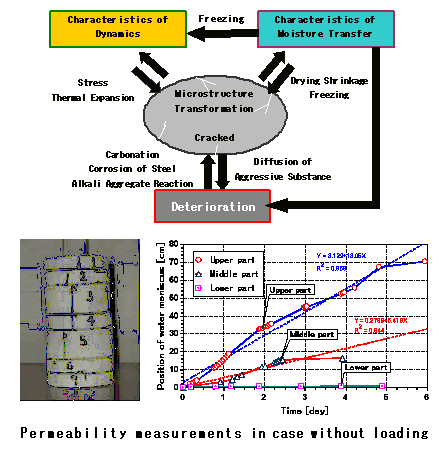
Evaluation of Spatial Distribution of Moisture Transfer Characteristics Taking into Account the Dynamics Effect in Various Concretes
| Tel: +81-(0)11-706-7587 |
 Researcher:
Researcher:
 Yoshihiko Kishimoto
Yoshihiko Kishimoto

Background
Concrete structures deteriorate due to many external and internal factors, such as alkali aggregate reaction, repetition of drying and wetting processes, and neutralization due to acid substances such as carbon dioxide.Permeability is one of the important parameters in discussing the deterioration of a concrete structure. However, there is little research that takes the influence of liquid movement on the deterioration into account.
Furthermore, the permeability depends significantly upon surface quality of concrete and type of aggregate. In addition, there are many cracks caused by various dynamic loads on the structure. When a crack is generated, characteristics of moisture transfer around the crack may differ significantly from that far from the crack. If the permeability varies depending upon the position in the structure, the deterioration rate may also differ from place to place.
Therefore, the purpose of this study is to establish analytical model of moisture transfer emphasizing liquid movement and influence of cracks, which is applicable to OPC, concrete treated with silane, and recycled concrete.Techniques
In this study, concrete permeability and crack distribution are measured by each part of test pieces in order to clarify effect of static load on moisture transfer characteristics and spatial distribution. Next, RBSM to simulate fracture mechanism is coupled with nonlinear simultaneous heat and moisture transfer model which can deal with liquid and vapor transfer individually.The proposed analytical model is validated by a comparison with the experimental results, and is used to investigate interaction between fracture progress and variation of moisture transfer.

